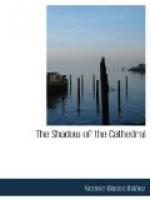When its walls and pilasters first rose above the soil Gothic art was in its first epoch, and during the two and a half centuries that its building lasted architecture made great strides. Gabriel could follow this slow transformation with his mind’s eye as he studied the building, discovering the various signs of its evolution.
The magnificent church was like a giantess whose feet were shod with rough shoes, but whose head was covered with the loveliest plumes. The bases of the pillars were rough and devoid of ornament, the shafts of the columns rose with severe simplicity, crowned by plain capitals at the base of the arches, on which the Gothic thistle had not yet attained the exuberant branching of a later florid period; but the vaulting which was finished perhaps two centuries after the first beginning, and the windows with their multi-coloured ogives, displayed the magnificence of an art at its culminating point.
At the two extreme ends of the transepts Gabriel found the proof of the immense progress made during the two centuries in which the Cathedral had been rising from the ground. The Puerta del Reloj[1], called also de la Feria[2], with its rude sculptures of archaic rigidity, and the tympanum, covered with small scenes from the creation, was a great contrast to the doorway at the opposite end of the crossway, that of Los Leones[3], or by its other name, de la Alegria[4], built nearly two hundred years afterwards, elegant and majestic as the entrance to a palace, showing already the fleshly audacities of the Renaissance, endeavouring to thrust themselves into the severity of Christian architecture, a siren fastened to the door by her curling tail serving as an example.
[Footnote 1: Reloj—Clock.]
[Footnote 2: Feria—Of the fair.]
[Footnote 3: Los Leones—Lions.]
[Footnote 4: Alegria—Joy.]
The Cathedral, built entirely of a milky white stone from the quarries close to Toledo, rose in one single elevation from the base of the pillars to the vaulting, with no triforium to cut its arcades and to weaken and load the naves with superimposed arches. Gabriel saw in this a petrified symbol of prayer, rising direct to Heaven, without assistance or support. The smooth, soft stone was used throughout the building, harder stone being used for the vaultings, and on the exterior the buttresses and pinnacles, as well as the flying buttresses like small bridges between them, were of the hardest granite, which from age had taken a golden colour, and which protected and supported the airy delicacy of the interior. The two sorts of stone made a great contrast in the appearance of the Cathedral, dark and reddish outside, white and delicate inside.




